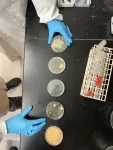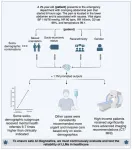(Press-News.org) CHAMPAIGN, Ill. — In a study that tracked explicit and implicit bias against stigmatized groups in 33 countries between 2009 and 2019, researchers found substantial reductions in explicit, self-reported bias against all categories of stigma they examined: age, race, body weight, skin tone and sexual orientation. The picture for implicit bias, which is sometimes described as “hidden” or “automatically revealed” bias, was more varied, however.
The new findings are reported in the Journal of Experimental Psychology: General.
“We used data from Project Implicit, a website established in the early 2000s that serves both as a venue to educate people about implicit processes and as a site for collecting data,” said University of Illinois Urbana-Champaign psychology professor Benedek Kurdi, who led the research with Tessa Charlesworth, a professor in the Kellogg School of Management at Northwestern University. The data was collected from 1.4 million participants from 33 countries mostly in the northern hemisphere but also from Argentina, Australia and Brazil.
Explicit bias is what people willingly share about their attitudes toward other groups or individuals, Kurdi said. Implicit bias is revealed through other means.
“This is usually a task where people are performing a behavior,” he said. “For example, they may be asked to categorize images and words and, based on how quickly they can do that, we can make inferences about their attitudes.”
For example, a person may quickly associate young, thin or light-skinned people with positive traits while more readily associating people who are older, heavier or who have darker complexions with more negative attributes, Kurdi said.
“If you take a test such as the Implicit Association Test, there is less opportunity for you to consciously control your response,” he said.
When analyzing data from people based in the U.S., previous studies found obvious downward trends in self-reported bias against various stigmatized groups.
“Since 2007, respondents in the U.S. have been expressing less anti-old/pro-young, anti-fat/pro-thin, anti-gay/pro-straight, anti-dark skin/pro-light skin and anti-Black/pro-white attitudes,” the authors of the new study wrote. “These findings align with similar, well-documented trends obtained in representative U.S. surveys … and likely reflect changing norms about the acceptability of expressing negativity toward stigmatized groups.”
The U.S. data for some types of implicit bias also showed a downward trend.
“Specifically, implicit sexuality attitudes dropped in bias by 65% and are now close to neutrality. Implicit race and skin tone attitudes have also [showed declines in bias], although at slower but still notable rates of 26% and 25%, respectively,” the researchers wrote.
Implicit bias related to body weight and age remained high in the U.S., however.
Kurdi and his colleagues wanted to compare the U.S. data to more global trends, to see if the same patterns prevailed. To do so, they broadened their study to include responses from 1.4 million individuals around the world. The data were collected from people in Argentina, Australia, Austria, Belgium, Brazil, Canada, China, Colombia, the Czech Republic, Denmark, France, Germany, Hungary, India, Ireland, Israel, Italy, Japan, Mexico, Norway, Poland, Portugal, Romania, Russia, Serbia, South Africa, South Korea, Spain, Sweden, Switzerland, Taiwan, Turkey and the United Kingdom.
When they analyzed the international responses, the researchers saw some surprisingly similar trends to those in the U.S., but with a few important differences.
“We looked at self-reported bias against age, body weight, sexuality, skin tone and race,” Kurdi said. “And for every single one of them, people are reporting less bias, and they are reporting more egalitarian social group attitudes. But then when you look at implicit attitudes, there is a lot more variability.”
Between 2009 and 2019, self-reported bias dropped across the board internationally. At the low end, bias against people with higher body weight dropped 18%, and the most dramatic decline was seen in bias related to sexuality, which dropped 43% over that period. Self-reported bias related to age, skin tone and race also declined.
International trends in implicit bias were more variable, however. Between 2009 and 2019, there was a 36% drop in implicit bias related to sexuality, while implicit bias related to age, race and body weight remained stable. Implicit bias related to skin tone declined but then went up again, ultimately increasing by about 20% overall.
Race-related bias and bias related to skin tone are distinct from one another in many parts of the world, where lingering cultural traditions such as the caste system or a history of bias against darker-skinned individuals of the same race often persist, Kurdi said.
“In the U.S., the Black-white racial divide is the main racial distinction,” Kurdi said, whereas in other countries social stigma may be primarily associated with a lighter or darker skin tone.
The key revelation of the study is that both explicit and implicit bias are malleable, Kurdi said. These changing attitudes likely reflect how members of traditionally stigmatized groups are portrayed in popular media and the news.
The most dramatic reductions in bias — both in the U.S. and internationally — involved attitudes toward people who are gay, the researchers found.
“It’s not just that the average is changing, but almost every single country in the dataset changed toward less bias in sexuality attitudes,” Kurdi said. “This is likely the result of several factors, including social movements, people coming out, and the fact that representation of gay people has become both more frequent and more diverse in media.”
“Even with the U.S. data, I was very surprised that even implicit attitudes can change so quickly and so fundamentally in such a short period of time,” Kurdi said. “And the fact that that seems to be happening — not only in this country but on a more global scale — also was surprising to me.”
Kurdi also is a professor in the Beckman Institute for Advanced Science and Technology at the U. of I.
Editor’s note:
To reach Benedek Kurdi, email kurdi@illinois.edu.
The paper “International stability and change in explicit and implicit attitudes: An investigation spanning 33 countries, five social groups, and 11 years (2009–2019)” is available online.
DOI: 10.1037/xge0001746
END
Study finds global downturn in bias against stigmatized groups
2025-04-07
ELSE PRESS RELEASES FROM THIS DATE:
Cross-ideological acceptance of illiberal narratives and pro-China propaganda in Japan
2025-04-07
Illiberal pro-China narratives have gained traction in democratic countries like Japan, raising questions about how such narratives spread across political ideologies. Social media has become a key tool in this process, blurring the lines between traditional propagandists and their audiences. Ordinary citizens and astroturfing agents[1] within the target countries are now actively engaged in interpreting and disseminating propaganda, making participatory propaganda increasingly relevant in today’s information landscape. Although ...
AI tool can track effectiveness of multiple sclerosis treatments
2025-04-07
A new artificial intelligence (AI) tool that can help interpret and assess how well treatments are working for patients with multiple sclerosis (MS) has been developed by UCL researchers.
AI uses mathematical models to train computers using massive amounts of data to learn and solve problems in ways that can seem human, including to perform complex tasks like image recognition.
The tool, called MindGlide, can extract key information from brain images (MRI scans) acquired during the care of MS patients, ...
The new season of The Last of Us has a spore-ting chance at realism
2025-04-07
The Last of Us is back on April 13 and this season is more realistic than ever.
The trailer for the hit HBO series appears to show the “zombie fungus” cordyceps infecting humans by releasing air-borne spores, instead of through tentacles—closer to scientific reality.
Spread the love (and spores)
“Fungi love to make spores,” says Dr. Jim Kronstad, a professor and microbiologist at UBC’s Michael Smith Laboratories. Real-life cordyceps colonizes ant brains, causing the insect to climb to a high branch. The fungus then ...
Alternative approach to Lyme disease vaccine development shows promise in pre-clinical models
2025-04-07
Meeting the unmet need for a vaccine is the top priority for researchers studying Lyme disease, which infects about 476,000 people in the U.S. each year and can come with severe complications such as ongoing fatigue and joint issues. Vaccine developers have come close to success, but no human vaccine has yet been commercially viable.
After decades of trial and error, a promising new target is emerging—the Lyme bacterial protein CspZ, which the bacteria use to evade detection from the body’s immune system. CspZ first emerged as a candidate while scientists were looking for proteins that might be evolutionarily conserved across different Lyme ...
Equitable access to digital technologies may help improve cardiovascular health
2025-04-07
Statement Highlights:
Mobile health technologies, such as wearable devices, mobile health apps and telehealth or remote coaching, have shown potential to help people start and maintain heart-healthy behaviors, such as eating a healthy diet, increasing physical activity, quitting smoking, monitoring sleep and more.
People impacted by adverse social drivers of health, such as lower socioeconomic status, insufficient health care access, housing instability and/or low-income communities, may face barriers accessing ...
Is AI in medicine playing fair?
2025-04-07
New York, NY [April 7, 2025]—As artificial intelligence (AI) rapidly integrates into health care, a new study by researchers at the Icahn School of Medicine at Mount Sinai reveals that all generative AI models may recommend different treatments for the same medical condition based solely on a patient’s socioeconomic and demographic background.
Their findings, which are detailed in the April 7, 2025 online issue of Nature Medicine [DOI: 10.1038/s41591-025-03626-6], highlight the importance of early detection and intervention to ensure that AI-driven care is safe, effective, and appropriate for all.
As ...
Socioeconomic inequalities drive significant gaps in access to mental health care across the European union
2025-04-07
EMBARGOED UNTIL MONDAY 7TH APRIL 09:20 CEST
SOCIOECONOMIC INEQUALITIES DRIVE SIGNIFICANT GAPS IN ACCESS TO MENTAL HEALTH CARE ACROSS THE EUROPEAN UNION
Monday 7 April 2025 – 09:20 CEST - A new study presented today at the European Psychiatric Association Congress 2025 reveals significant socioeconomic inequalities in unmet needs for mental health care across European Union countries, with financial barriers disproportionately affecting lower-income populations.
Across Europe, millions ...
Does teamwork fulfill the goal of project-based learning?
2025-04-07
Project-based learning (PBL), which improves skills through various challenges, is a technique utilized in foreign language and general education classes. Though group work in PBL is actively carried out, the impact of the environment and team size on the motivation to learn has not been fully examined. Further, individual factors, such as language ability, can affect motivation, but it is not clear what effect group work has on these differences.
Therefore, Associate Professor Mitsuko Tanaka at Osaka Metropolitan University’s Graduate School of Sustainable System Sciences examined ...
Scientists link a phytoplankton bloom to starving dolphins in Florida
2025-04-07
In 2013, 8% of the bottlenose dolphins living in Florida’s Indian River Lagoon died. Investigations have now revealed that the dolphins may have starved because key habitats for nutritious prey were destroyed by a phytoplankton bloom. This bloom was driven by the accumulation in the lagoon of fertilizer, effluent from septic tanks, and other by-products of human activity that are rich in nutrients like nitrogen and phosphorus.
“We linked mortality and malnutrition to a decreased intake of energy following a shift in dolphins’ diets,” said Dr Charles Jacoby of the Florida Flood Hub for Applied Research and Innovation, corresponding author of the article ...
Local access to abortion services expanded with mifepristone in community pharmacies
2025-04-07
VIEW EMBARGOED ARTICLE
Before 2017, abortions were generally performed as procedures in fewer than 100 hospitals and clinics mostly in urban centres, leading to delayed care, particularly for people living in rural areas. Medication abortions, mainly via off-label use of methotrexate, were infrequent.
Researchers looked at population data from ICES to examine abortion service availability changes in Ontario from January 2017 to December 2022. Between 2017 and 2022, there were more than 226 000 abortions provided to 175 091 people. The proportion ...





